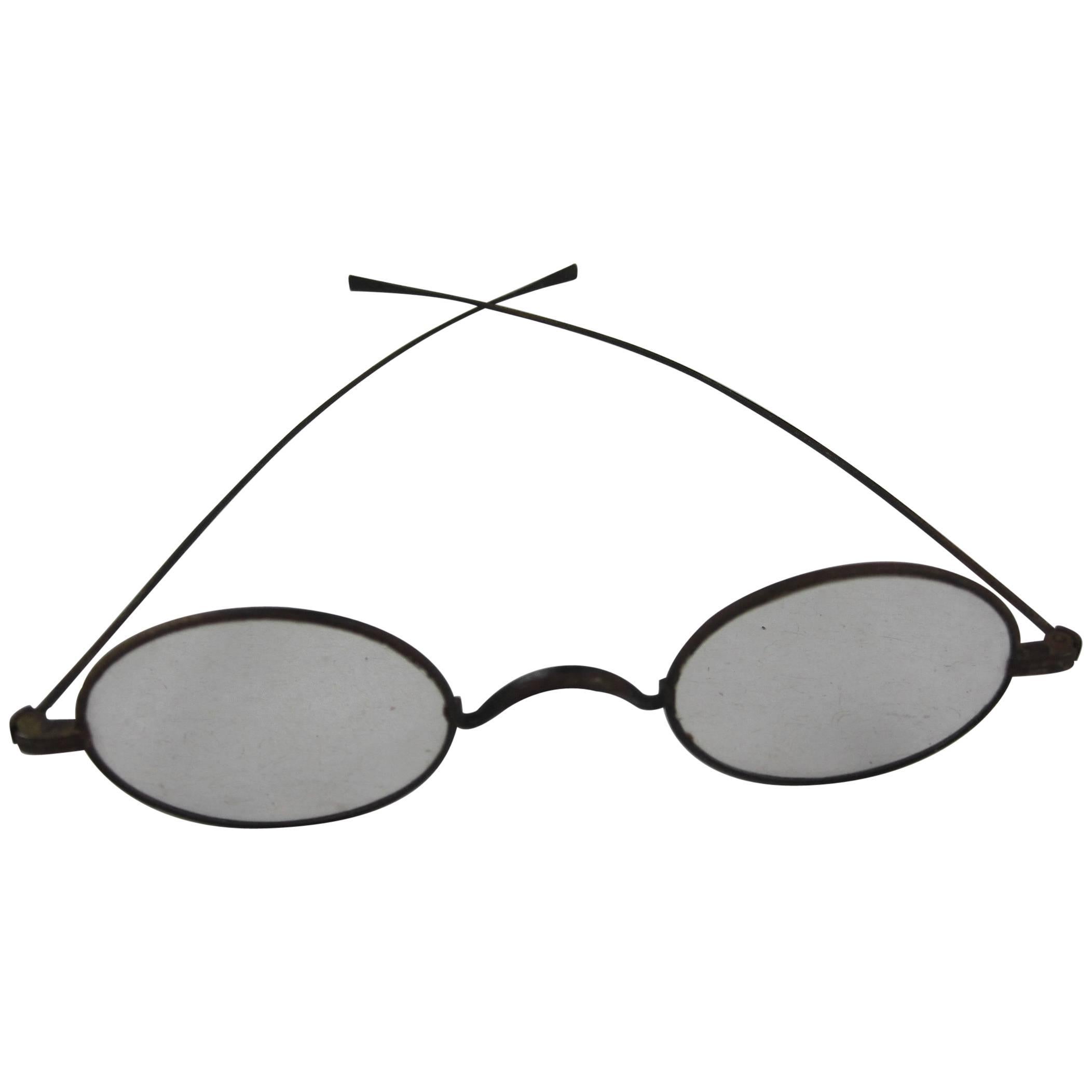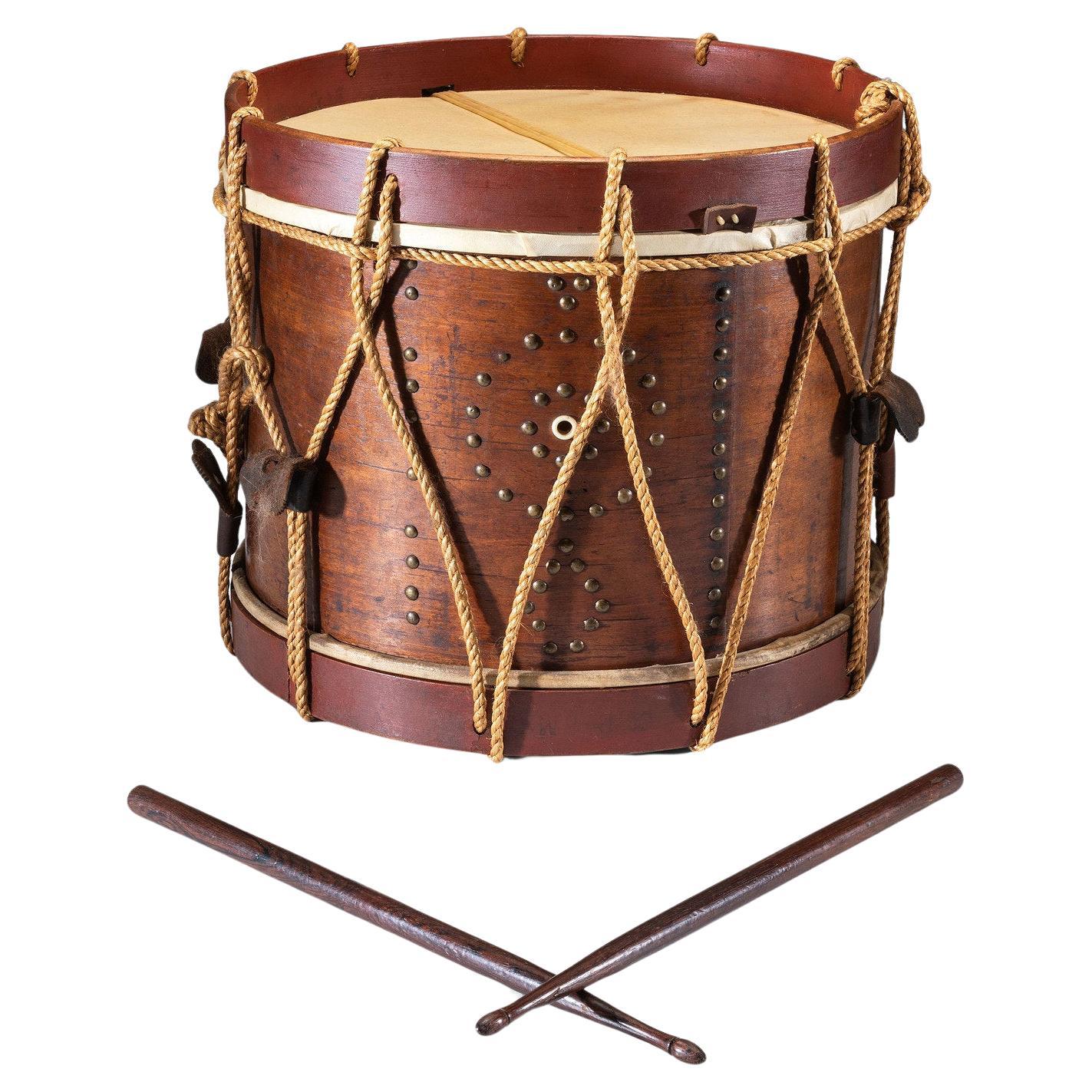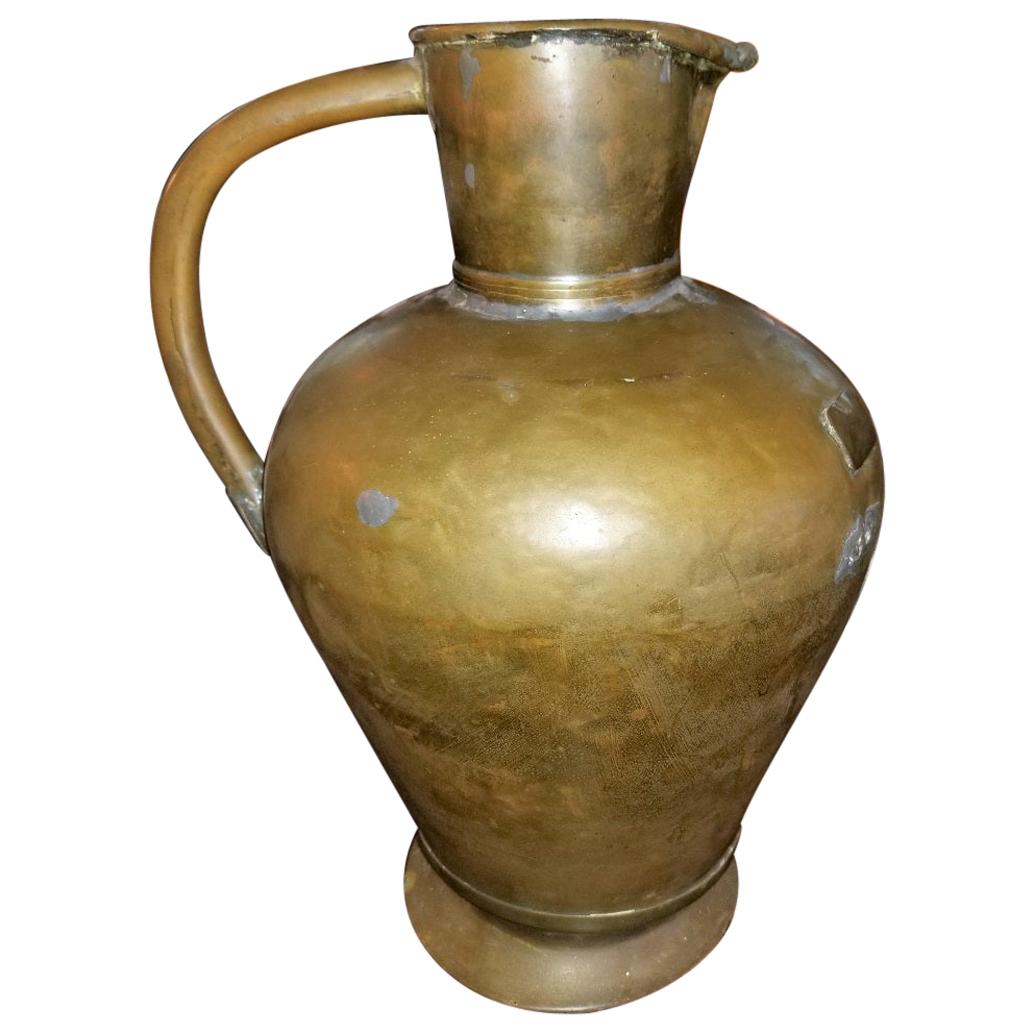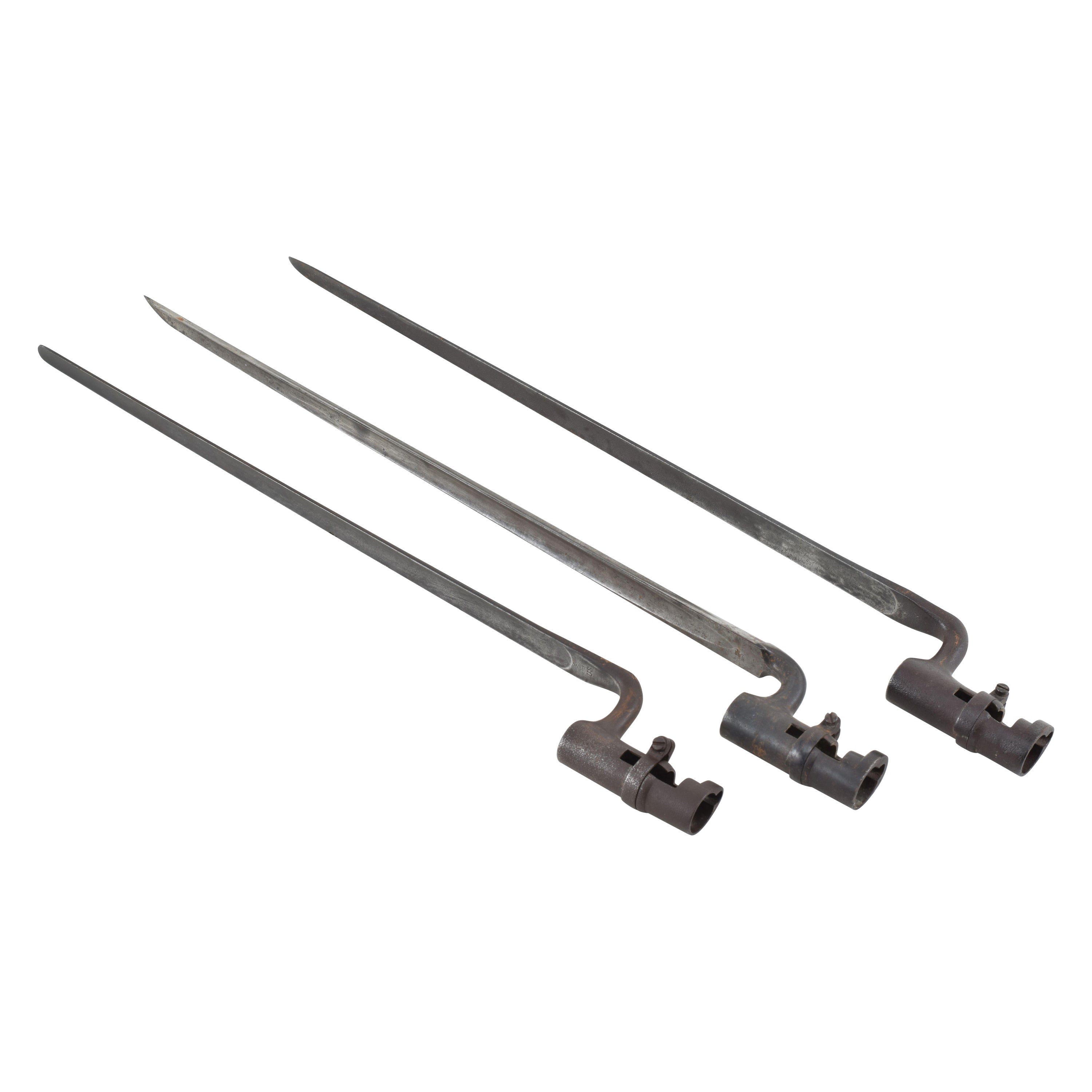Items Similar to Antique Civil War Era Leg Brace or Splint with Metal, Brass & Wood Construction
Want more images or videos?
Request additional images or videos from the seller
1 of 11
Antique Civil War Era Leg Brace or Splint with Metal, Brass & Wood Construction
About the Item
This antique Civil War era primitive leg brace or splint is unsigned, but presumed to have been made in the United States in circa 1860. The brace is constructed predominately from cut and hand forged steel panels fastened together with crude eyelets with a very sturdy cast brass fastener on the back and a wooden platform that can be moved up and down as a foot rest. There is an interesting bracket on the bottom with two holes on either side which appears to be for fastening the base to a surface to secure it. This is a very crude and early example of a utilitarian medical device, which is considerably large and heavy. And would not have been easy to wear for any period of time.
- Dimensions:Height: 37 in (93.98 cm)Width: 8.5 in (21.59 cm)Depth: 5 in (12.7 cm)
- Style:Primitive (Of the Period)
- Materials and Techniques:
- Place of Origin:
- Period:
- Date of Manufacture:1865
- Condition:Wear consistent with age and use. No damage identified. It may have used straps of some sort to hold the leg in this primitive brace, and if so, they are missing.
- Seller Location:Hamilton, CA
- Reference Number:1stDibs: LU1355220310262
About the Seller
5.0
Platinum Seller
These expertly vetted sellers are 1stDibs' most experienced sellers and are rated highest by our customers.
Established in 2010
1stDibs seller since 2015
1,218 sales on 1stDibs
Typical response time: <1 hour
- ShippingRetrieving quote...Ships From: Hamilton, Canada
- Return PolicyA return for this item may be initiated within 3 days of delivery.
More From This SellerView All
- Large Mid-Century Era Brass Church Cross or Crucifix with Stepped BaseLocated in Hamilton, OntarioThis large brass and brass plated church cross was made by Sudbury, presumably of the United States, in approximately 1970 in a Mid-Century Modern style. ...Category
Mid-20th Century American Mid-Century Modern Religious Items
MaterialsBrass
- Antique WW1 Era Brass Trench Art Engraved Shell Casing Dinner Bell or GongLocated in Hamilton, OntarioThis very unique and interesting engraved shell casing is unsigned with respect to its maker, but presumed to have been made in possibly Kuwait or Turkey in circa 1917 in a Folk Art style. The shell casing is from an enormous solid brass artillery shell that has been cut and fashioned into a well tuned bell or gong. The shell has been engraved with various panels or vignettes such as doves, palm trees, a landscape and a central crest identifying the years it commemorates. The dinner, meeting or prayer bell...Category
Early 20th Century Kuwaiti Folk Art Historical Memorabilia
MaterialsBrass
- Large Mid-Century Era Brass Plated Christian Church Cross or CrucifixLocated in Hamilton, OntarioThis large brass plated cross is unsigned, but presumed to have originated from Italy and dating to approximately 1970 and done in the period Mid-Cen...Category
Mid-20th Century American Mid-Century Modern Religious Items
MaterialsBrass
- Large Mid-Century Era Metal Cigarette Case with World Globe & Compass DecorationLocated in Hamilton, OntarioThis large cigarette case was made by the well known Wadsworth's of Canada and dates to approximately 1970 and done in the period Mid-Century Modern style. The box is composed of eng...Category
Mid-20th Century Canadian Mid-Century Modern Tobacco Accessories
MaterialsMetal
- Midcentury Era Chesterfield Cigarette Metal Tobacciana Advertising SignLocated in Hamilton, OntarioThis midcentury period embossed and painted tin advertising sign was made for the Liggett and Myers Tobacco Company in circa 1965 to promote their Chesterfield cigarette...Category
Mid-20th Century American Mid-Century Modern Tobacco Accessories
MaterialsMetal
- Antique Art Nouveau Photo Album or Book with Brass Stand Up FrameLocated in Hamilton, OntarioThis antique standing photo album is unsigned, but presumed to have originated from France and date to approximately 1900 and done in the period Art Nouveau style. The album is compo...Category
Antique Late 19th Century French Art Nouveau Books
MaterialsBrass
You May Also Like
- 36 Star American Flag, Civil War Era, Nevada StatehoodLocated in York County, PA36 Stars In The "Great Star" Or "Great Luminary" Pattern On A Civil War Era Flag With A Dusty Blue Canton And A Section Of One Stripe Souvenired, 1864-67, Nevada Statehood 36 star American national flag of the Civil War era, entirely hand-sewn and with some rare and beautiful features. The stars are arranged in a rendition of what is known as the Great Star or Great Luminary configuration, a large star made out of smaller stars. With no official star pattern before 1912, their design was left up to the artistic liberties of the flag-maker. Strikingly visual, the Great Star is both scarce and coveted by collectors. The 36th state, Nevada, entered the Union during the Civil War on October 31st, 1864. The last Confederate general surrendered on May 26th, 1865. The 36 star flag became official on July 4th of that year, but makers of printed flags would have begun adding a 36th star to their flags in 1864, even before the addition of the new state occurred. Lincoln pushed Nevada through just 8 days before the November election. Nevada’s wealth in silver was attractive to a nation struggling with the debts of war and increased support for the Republican ticket. The 36 star flag was replaced by the 37 star flag in 1867, with the addition of Nebraska. Adding to the flag's appeal is its small scale across those with of piece-and-sewn construction. During the 19th century, sewn flags (as opposed to those that were printed on cloth) were typically eight feet long and larger. This is because they were important in their function as signals, meaning that they needed to be seen and recognized from great distance. A flag that was six feet in length was considered small and production of flags smaller than this was extremely limited. Even infantry battle flags were approximately six by six and-one-half feet, about the size of an average quilt of the same period. As time passed, circumstances changed and sewn flags began to find more of a decorative purpose. Smaller flags are more scarce and far easier to frame and display. The Great Star configuration appears to have come about shortly after the War of 1812, when Congressman Peter Wendover of New York requested that Captain Samuel Reid, a War of 1812 naval hero, create a new design that would become the third official format of the Stars & Stripes. A recipient of the Congressional Medal of Honor, Reid became harbor master of New York following the war. During his lifetime, he created many innovations in signal use, including a system that could actually send messages from New York to New Orleans by sea in just two hours. Use as a Naval signal had been the primary reason for the initial creation of an American national flag in 1777, but since there was no official star design, the appearance of our flag varied greatly. Reid’s primary concern centered on both consistency and ease of recognition. His hope was as more and more states joined the Union and more and more stars were added to the flag, that it would remain easily identified on the open seas. In 1818, Reid suggested to Congress that the number of stripes permanently return to 13 (reduced from 15) and that the stars be grouped into the shape of one large star. Reid’s proposal would have kept the star constellation in roughly the same format, in a pattern that could be quickly identified through a spyglass as the number of states grew. His concept for the stripes was ultimately accepted, but his advice on the star pattern was rejected by President James Monroe, due to the increased cost of arranging the stars in what would become known as the “Great Star”, “Great Flower”, or “Great Luminary” pattern. Monroe probably didn’t wish to impose this cost on either the government or civilians, so he suggested a simple pattern of justified rows. Never-the-less, the Great Star was produced by anyone willing to make it and its rarity today, along with its beauty, has driven the desirability of American flags with this configuration. The canton and stripes of the flag are made of fine merino wool. Note how the canton has faded to a dusty seafoam blue, which is endearingly attractive. The stars of the flag are hand-sewn and single-appliquéd. This means that they were applied to one side of the canton, then the blue fabric was cut from behind each star, folded over, and under-hemmed, so that one star could be viewed on both sides of the flag. I always find single-appliquéd stars more interesting, not only because they are evidence of a more difficult level of seam-work and stitching, but also because they are more visually intriguing. The two visible rows of hand-stitching emphasize their hand-sewn construction, which is one reason why flags with single-appliquéd stars often appeal to connoisseurs of early American textiles...Category
Antique 1860s American Political and Patriotic Memorabilia
MaterialsWool
- Vintage Civil War Era Field Glasses by Queen & Co.Located in Colorado Springs, COPresented is an original pair of Civil War-era field glasses. The glasses, an intricate example of brass and glass technology, were made in Philadelphia, Pennsylvania by the company Queen & Co. The glasses are stamped “Queen & Co., Phila” along the eyepiece. They are housed in the original leather hard case. The glasses were most likely made in the early 1860s. Binoculars were first invented in France in the 1840s. They started small, primarily as opera glasses, but by the Civil War, they were being used in battle. Larger versions, like the pair seen here, became known as field glasses. Unlike Civil War uniforms...Category
Antique 1860s American Historical Memorabilia
MaterialsBrass
- Historical American Civil War Era Wire Frame Magnifying Eye Glass SpectaclesLocated in Philadelphia, PAA delicate pair of handmade magnifying wire rim eye glasses from the American Civil War era, circa 1860. A great looking historical conversation p...Category
Antique Mid-19th Century American American Classical Historical Memorabilia
MaterialsMetal
- Civil War-Era Side Drum, Made by George Kilbourn, 1859Located in Colorado Springs, COPresented is an original Civil War-era side drum with a pair of wooden drumsticks. This is a rope tension drum with a wooden body, ropes, and leather tabs. An iron tack pattern surro...Category
Antique 1850s American American Classical Musical Instruments
MaterialsIron
- 19th Century Large Civil War Era Bronze and Tin PitcherLocated in Dallas, TXPresenting a fabulous historic treasure of times past, namely, a 19th century large Civil War Era bronze and tin pitcher. From circa 1850, this is an American frontier piece. I...Category
Antique Mid-19th Century American American Classical Pitchers
MaterialsBrass, Bronze, Copper, Tin
- Civil War Socket BayonetsLocated in Norton, MAThree Socket Bayonets. One is a P-53 Civil War era marked "DEAKIN" and has a crown over 53, one is a "US" stamped dull tip, and the last is unmarked or stamped.Category
Antique 19th Century American Arms, Armor and Weapons
MaterialsMetal
Recently Viewed
View AllMore Ways To Browse
Antique Wood Legs
Wood Antique Furniture Legs
Antique Brass Legs
Antique Brass Furniture Legs
Wood Construction
Antique Metal Legs
Used Wood Machines
Cast Metal And Wood
Antique Wooden Legs
Antique Foot Rest
Antique Metal Panel
Civil War Antiques
Machine Legs
Antique War Memorabilia
Wooden Platform
Antique Cut Steel
Large Wood Primitive
Cast Metal Panel





